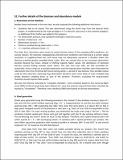Files in this item
Continental-scale biomass redistribution by migratory birds in response to seasonal variation in productivity
Item metadata
| dc.contributor.author | Ng, Wee Hao | |
| dc.contributor.author | Fink, Daniel | |
| dc.contributor.author | La Sorte, Frank A. | |
| dc.contributor.author | Auer, Tom | |
| dc.contributor.author | Hochachka, Wesley M. | |
| dc.contributor.author | Johnston, Alison | |
| dc.contributor.author | Dokter, Adriaan M. | |
| dc.date.accessioned | 2023-02-21T00:39:23Z | |
| dc.date.available | 2023-02-21T00:39:23Z | |
| dc.date.issued | 2022-04-01 | |
| dc.identifier | 277965052 | |
| dc.identifier | 241f156e-89c9-4019-ba88-1531ab5a8b36 | |
| dc.identifier | 85124884951 | |
| dc.identifier | 000758242000001 | |
| dc.identifier.citation | Ng , W H , Fink , D , La Sorte , F A , Auer , T , Hochachka , W M , Johnston , A & Dokter , A M 2022 , ' Continental-scale biomass redistribution by migratory birds in response to seasonal variation in productivity ' , Global Ecology and Biogeography , vol. 31 , no. 4 , pp. 727-739 . https://doi.org/10.1111/geb.13460 | en |
| dc.identifier.issn | 1466-822X | |
| dc.identifier.other | RIS: urn:7571CB32BD43A7298220CC335A6D91A0 | |
| dc.identifier.other | ORCID: /0000-0001-8221-013X/work/108919394 | |
| dc.identifier.uri | https://hdl.handle.net/10023/27017 | |
| dc.description | Funding: This work was funded in part by The Leon Levy Foundation, The Wolf Creek Foundation and the National Science Foundation (ABI sustaining: DBI-1939187; MSA: DEB-2017817; computing support from CNS-1059284 and CCF-1522054). | en |
| dc.description.abstract | Aim Animal migration is often explained as the result of resource tracking in seasonally dynamic environments. Therefore, resource availability should influence both the distributions of migratory animals and their seasonal abundance. We examined the relationship between primary productivity and the spatio-temporal distributions of migratory birds to assess the role of energy availability in avian migration. Location North America. Time period Full annual cycle, 2011-2016. Major taxa studied Nocturnally migrating landbirds. Methods We used observations of nocturnally migrating landbirds from the eBird community-science programme to estimate weekly spatial distributions of total biomass, abundance and species richness. We related these patterns to primary productivity and seasonal productivity surplus estimated using a remotely sensed measure of vegetation greenness. Results All three avian metrics showed positive spatial associations with primary productivity, and this was more pronounced with seasonal productivity surplus. Surprisingly, biomass showed a weaker association than did abundance and richness, despite being a better indicator of energetic requirements. The strength of associations varied across seasons, being the weakest during migration. During spring migration, avian biomass increased ahead of vegetation green-up in temperate regions, a pattern also previously described for herbivorous waterfowl. In the south-eastern USA, spring green-up was instead associated with a net decrease in biomass, and winter biomass greatly exceeded that of summer, highlighting the region as a winter refuge for short-distance migrants. Main conclusions Although instantaneous energy availability is important in shaping the distribution of migratory birds, the stronger association of productivity with abundance and richness than with biomass suggests the role of additional drivers unrelated to energetic requirements that are nonetheless correlated with productivity. Given recent reports of widespread North American avifaunal declines, including many common species that winter in the south-eastern USA, understanding how anthropogenic activities are impacting winter bird populations in the region should be a research priority. | |
| dc.format.extent | 13 | |
| dc.format.extent | 4829585 | |
| dc.format.extent | 2060052 | |
| dc.language.iso | eng | |
| dc.relation.ispartof | Global Ecology and Biogeography | en |
| dc.subject | Abundance | en |
| dc.subject | Biomass | en |
| dc.subject | eBird | en |
| dc.subject | North America | en |
| dc.subject | Productivity | en |
| dc.subject | Seasonal bird migration | en |
| dc.subject | Species–energy relationship | en |
| dc.subject | Species richness | en |
| dc.subject | Vegetation greenness | en |
| dc.subject | GE Environmental Sciences | en |
| dc.subject | QA Mathematics | en |
| dc.subject | QH301 Biology | en |
| dc.subject | QL Zoology | en |
| dc.subject | DAS | en |
| dc.subject | AC | en |
| dc.subject | MCC | en |
| dc.subject.lcc | GE | en |
| dc.subject.lcc | QA | en |
| dc.subject.lcc | QH301 | en |
| dc.subject.lcc | QL | en |
| dc.title | Continental-scale biomass redistribution by migratory birds in response to seasonal variation in productivity | en |
| dc.type | Journal article | en |
| dc.contributor.institution | University of St Andrews. Statistics | en |
| dc.contributor.institution | University of St Andrews. Centre for Research into Ecological & Environmental Modelling | en |
| dc.identifier.doi | https://doi.org/10.1111/geb.13460 | |
| dc.description.status | Peer reviewed | en |
| dc.date.embargoedUntil | 2023-02-20 |
This item appears in the following Collection(s)
Items in the St Andrews Research Repository are protected by copyright, with all rights reserved, unless otherwise indicated.


